Early Arenas of Hotel Control
As reformers organized to fight urban architectural problems, they did not move from one strategy to another in a simple chronological line or scale of intervention. Nor were all of the measures Progressive Era developments. Some of the strategies, particularly moral codes, had been tried in California well before 1912 and the founding of the CIH. The targets also shifted. The reformers aimed their building codes particularly at cheap lodging houses and the worst rooming houses—the
bottom two-thirds of the hotel market. Zoning promised to control the entire market but only in the new sections of the city.
Enforcement of Moral Codes
At the simplest level, reformers sought to control what they perceived as aberrant social lives by controlling the behavior itself. Beginning in the nineteenth century, various San Francisco reform committees fought for city controls against the sins of downtown life; they did this as a part of their mission hall programs, temperance promotion, and dance hall crusades. In 1903, the city's Board of Supervisors passed a set of mild restrictions against dancing, gambling, sexual solicitation, and cross-dressing. The city's gambling and whorehouse activities continued unabated.[12] In 1913, the state passed the Red Light Abatement Act, allowing authorities to close prostitution houses for up to a year. The Northern California Hotel Association joined the coalition that lobbied against the law, fearing that enforcement could too easily be brought against hotel owners. American entry into World War I stimulated a high wave of concern about vice districts. The ever-active Simon Lubin—with an eye to hotel connections with prostitution and as a member of a Sacramento welfare commission—railed against police corruption that kept "unregulated hotels and lodging houses spreading venereal diseases among the soldiers" at the local army camp.[13] Not all sexual alarms about hotels focused on prostitution or troop safety. Some social agencies recommended that hotel managers bar boys under the age of seventeen from cheap lodging houses, or at least prevent boys and men from rooming together, because of the dangers of homosexuality. For similar reasons, reformers elsewhere urged police to keep city boys from loitering or playing in streets and parks near the cheap lodging house districts.[14]
In 1919, federal Prohibition eliminated drinking in hotel bars and dining rooms and thereby slashed the most lucrative profits of hotel operation. The California Anti-Saloon League and the local WCTU, however, could do little to enforce Prohibition in San Francisco. As in the hotels of other cities, Prohibition merely moved drinking from the management-supervised areas of San Francisco hotels to private rooms, with dire consequences for furniture maintenance and cleaning bills.[15]
Parlor reform—the campaign to require sitting rooms in tenements and rooming houses and thereby to encourage quiet home life—was a milder moral reform that also affected hotels. In 1927, the Girls Hous-
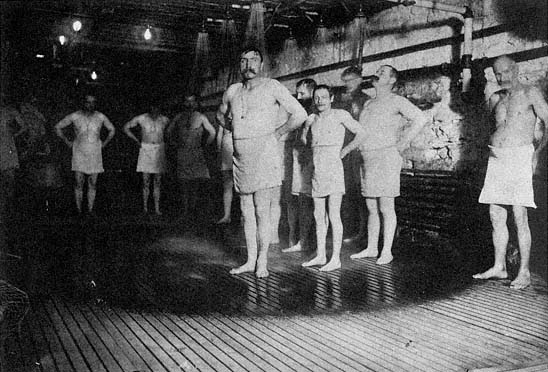
Figure 8.4
Creating social reform by changing individual behavior. Men taking a compulsory shower in a
New York City public lodging house, ca. 1900.
ing Council of San Francisco decried the long absence of rooming house parlors. Blocked from their goal of laws requiring sitting rooms, the matrons of San Francisco (like women's groups elsewhere) compiled a private registry of rooms. Volunteers inspected each address in the San Francisco registry and judged its respectability, cleanliness, and comfort. The resulting list was designed to prevent single girls from getting into morally dangerous situations when they followed up newspaper ads for a room. Some YMCAs offered similar services for men.[16] This regulation of behavior by private inspection was another means of changing or enforcing individual action.
For hoboes and other poorly dressed people, control of behavior was more direct and often rougher. When police caught drunks or panhandlers out of bounds in San Francisco, they were summarily sent back to the parts of the city "where they belonged" and roughed up if they did not go kindly. The showers required at least once a week in some municipal lodging houses were yet another means of inducing new behavior as well as hygiene (fig. 8.4).[17]
Control over hotel life simply by control of behavior proved ineffective. Prohibition's financial effects on hotels were unintended side effects and hurt the better hotels more than the cheap rooming houses. Laws regulating drinking, dancing, and other social life required constant enforcement that was impossible to provide. In contrast, regulating the environmental conditions of cheap hotels offered an approach that was literally more concrete and, to most observers, far more effective.
Building and Health Codes
Initially, housing activists were often convinced that building code enforcement was the answer to better housing for the poor. "The solution of the housing problem," Veiller wrote, "is to be found chiefly in legislation preventing the erection of objectionable buildings and securing the adequate maintenance of all buildings."[18] As part of the general implementation of codes, regulation writers attacked fundamental problems of hotel safety and sanitation: firetraps, dark rooms, inadequate plumbing, and insufficient ventilation (fig. 8.5). An entire system of codes had to be implemented. After initial passage of the ordinance came the training of staff to review plans, inspectors to check construction of new buildings, and often another set of inspectors to find later management violations.
San Francisco's earliest attempts to regulate hotels and lodging houses began in 1870 with an ordinance requiring sleeping rooms with at least 500 cubic feet of air space for each lodger; the state passed a similar ordinance in 1876. These laws were primarily aimed at the dwellings of single Chinese laborers. A Sacramento newspaper editor protested the discrimination, asking, "What better right has a Chinaman than a white man to be ventilated?"[19] However, enforcement was used not for environmental improvements but mostly for racial harassment. By the turn of the century, an occasional health inspector did invoke the 1876 law for the worst white lodging houses. San Francisco's other early hotel ordinances were concerned less with health and safety and more with licenses and fees, that is, until the 1906 earthquake and fire.[20] In the first year following the fire, the corrupt administration of boss Abe Ruef and Mayor Eugene Schmitz allowed almost any rebuilding scheme, which outraged reformers. In a political backlash of 1908 and 1909, activists rewrote the city plumbing and building
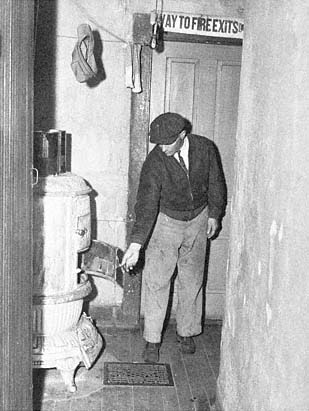
Figure 8.5
Heating stove in the hallway of a cheap hotel, Dubuque,
Iowa, 1940. Code enforcement worked to eliminate
hazards such as stoves which blocked access to fire exits.
laws. For the first time, health inspectors had the power to close non-conforming buildings. Also for the first time, San Francisco building owners experienced serious code enforcement; in 1909, the permit office rejected 75 percent of all the applications submitted. The single section of the new city building codes aimed specifically at hotels allowed cubicle-type rooms only in the most permanent and fireproof buildings; new, large, hastily constructed wooden lodging houses were outlawed.[21]
All subsequent hotel code restrictions came from the state. In 1909, California's legislature approved the first state housing law, a virtual carbon copy of the tenement code Veiller had written for New York City. California housing activists were not happy; they said legislators had been duped by the state's builders into allowing the densities of six-story Manhattan-style tenements when such buildings had not yet appeared in California cities.[22] The only mention of hotels in the 1909 state law was a significant "stables/lodging houses/rag storage" clause copied from Veiller:
No horse, cow, calf, swine, goat, rabbit, or sheep, chickens, or poultry shall be kept in a tenement house, or within 20 feet thereof on the same lot, and no tenement houses or lot or premises thereof, shall be used for a lodging house , or stable, or for the storage or handling of rags.[23]
Like Veiller, the California legislature had classified cheap hotels along with cattle and volatile rags as a prohibited nuisance use.
In 1913, prompted now by Lubin and his CIH experts in Governor Johnson's reform administration, state officials passed a short seven-page act specifically regulating hotels and lodging houses. The provisions of this act and other early actions show that the CIH, compared to its eastern counterparts, more actively included hotels in the public vision of housing. The CIH included officials from hotel organizations in their deliberations; they warned the city officials of Stockton, California, that they should supervise the construction of hotels as well as tenements or else slums would spring up. The first CIH housing survey included twenty-nine cheap lodging houses along with an area of immigrant cottage tenements.[24]
In 1917, the CIH pushed the legislature further. The state passed a trio of housing acts: a single dwellings act, a new tenement house act, and a comprehensive hotel and lodging house act that was very innovative. The new hotel act was thirty-nine pages—matching in detail the forty-one-page tenement act. The CIH properly crowed that its hotel law was "the most comprehensive in the U.S."[25] The Californians were breaking with standards automatically imported from elsewhere and were responding to local conditions with local ideas. This experiment in regional diversity would prove to be relatively short-lived.
Laws of other states had stronger details, but in its general conception, California's 1917 hotel act showed the framers' close familiarity with cheap hotel life. They allowed existing cubicle rooms to remain, and they included guidelines for open dormitory rooms; however, they outlawed new cubicle hotels.[26] Most important, the act set lasting bath-to-room ratios for the cheapest lodging houses: a separate water closet and shower on each floor for each sex, at the minimum ratio of 1 per 10 rooms or guests. Owners of existing hotels had to bring their toilet room ratios up to 1 to 12. These were strict requirements for the times. San Francisco's old requirements had been a ratio of 1 toilet room to 25 guests; New York required 1 water closet per 15 beds. The California hotel code matched the minimum window areas, room sizes,
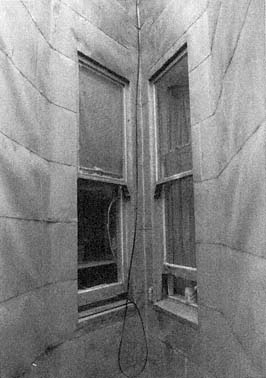
Figure 8.6
Window well in a San Francisco hotel built
to the city's 1909 codes. Later state housing
acts forbade narrow air wells like this one
at the National Hotel, a large rooming
house on Market Street.
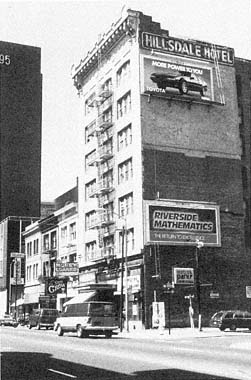
Figure 8.7
An imposing inexpensive hotel on two lots
next to smaller downtown rooming houses.
The scale of San Francisco's 82-room
Hillsdale Hotel, built in 1912 on Sixth Street
in the South of Market, was the wave of
the future for this building type.
and floor area per occupant in concurrent tenement house standards (fig. 8.6). In the new tenement act, the CIH had also rewritten Veiller's "stables/lodging houses/rag storage" clause so that it no longer included lodging houses as a nuisance use.[27]
The new California housing codes also worked for greater separation of people within more specialized rooms. Hotels and apartments were to have separate toilets for employees and guests. The 1917 code also contained this language about the separation of cooking and sleeping:
Food shall not be cooked or prepared in any room except in a kitchen designed for that purpose. Floors of kitchens and rooms in which food is stored shall be made impervious to rats by a layer of concrete . . . or a layer of sheet tin or iron or similar material.[28]
Local housing inspectors later had inspection forms listing "cooking and sleeping in the same room" as a violation category along with infractions such as "undersize rooms," "overcrowding," and "insufficient toilets." Kitchen measures like these were aimed at illegally sub-
divided houses and other light housekeeping rooms whose owners avoided inspection by not declaring cooking uses. Unbending rules on separate kitchens would become a major hurdle for the maintenance of hotel life after World War II.[29]
State housing inspectors kept up the code pressure on cheap hotels. Of the total inspections made in California cities in 1918, miscellaneous dwellings (largely shacks) required 26,000 inspections. More hotels were inspected (6,900) than tenements and apartments (5,900). By the 1920s, local San Francisco authorities had established a separate department of hotel and apartment inspection.[30]
Building codes had more specific effects than moral codes. For existing California hotels, code enforcement often raised rents but also spurred significant improvements for residents. As full-scale building inspection in San Francisco began in the 1920s, inspectors could—and did—push landlords to provide more livable amounts of ventilation and plumbing. Surviving records suggest that by 1930 even landlords like Edward Rolkin had brought their cheapest lodging houses close to the toilet and sink codes, even if the hotels did not benefit from regular cleaning.[31] For the rooming house rank, codes tacitly encouraged San Francisco speculators to provide larger, more prominent buildings (fig. 8.7). In 1910, small rooming houses with 15 to 40 rooms in a three-story walk-up building outnumbered larger rooming house buildings three to one. By 1930, three-fourths of the rooming house rooms in San Francisco were in large five- and six-story buildings with 70 to 160 rooms and elevator service. Along with efforts to reduce management costs and use more efficient mechanical systems, codes played an important part in this jump in scale (fig. 8.8). The larger light wells and more complicated plumbing also made the new, more specialized rooming houses less likely to be converted to commercial uses without substantial waste and unrentable space.
The more expensive hotels in San Francisco already had standards far above the code minimums. Thus, owners of the better hotels had little to fear from city housing inspectors, except for permanent guests who kept trying to cook in their rooms. One change seemingly a result of the 1917 codes was the end of California experiments with buildings that mixed rooming house units in apartment buildings. One such structure had thirty-six rooms with baths down the hall (all in the back of the building) and forty-five full-fledged apartments.[32]
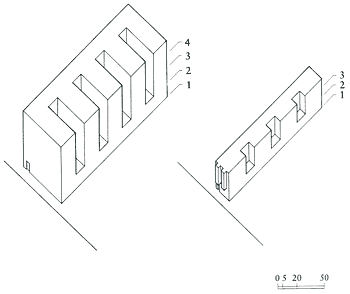
Figure 8.8
Typical sizes of rooming houses before and after effective building code
enforcement in San Francisco. Right , a 26-room structure built in 1910 with small air
shafts; left , a 157-room structure built in 1915 with the required larger air shafts.
Except in rare condemnation cases, building and sanitation codes controlled hotels but did not eliminate them from the housing stock. Research on Chicago has shown that codes enforced there in the 1920s made new cheap lodging houses unprofitable—thus retarding new construction of such hotels.[33] In San Francisco, the hotel supply was already plentiful and probably overbuilt after World War I. These uneven results of code regulation discouraged even Veiller. He wanted more of the city to be rebuilt, not just brought up to code minimums. More than once he expressed a wistful desire that New York "might be purified by fire, and that whole sections might be thus destroyed."[34]
Veiller's influence, along with his National Housing Association's focus on codes, waned in the 1920s. Codes were seen less as primary tools of social and cultural control and more as assurance for mortgage lenders and insurance agents. In other city departments, however, planners had been hammering out a way not simply to control the present but to control the future of the whole city.
Zoning to Control Future Growth
Citizens who shared the vision of the new city were uniformly concerned about mixed land use and high residential density. These were problems beyond the scope of building codes and good intentions (figs. 8.9, 8.10). Over the heads of all urban land investors hung the vultures of uncertainty and unpredictability, or as one developer put it, the problem of "premature and avoidable de-
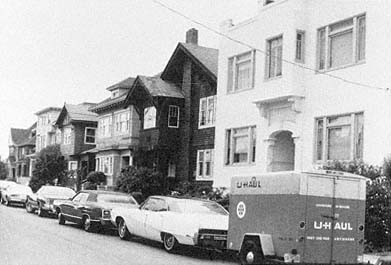
Figure 8.9
Street view of middle-income two-family and four-family houses on
Avon Street in Oakland, California, constructed between 1910 and 1925.
The light-colored Avon Hotel, at rear , appears to be another house.
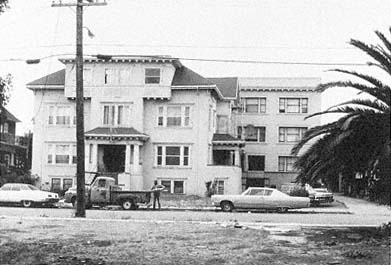
Figure 8.10
The Avon Hotel as it appears in the middle of the residential block.
Most zoning codes outlawed reproducing experiments like these.
preciation."[35] Moreover, one owner's adherence to codes had no automatic effect on buildings next door. If neighboring properties were sharply incompatible, spewing out noxious fumes, or crowded with the urban poor, then the value and potential use of even the best new building was sharply diminished.
The real estate industry in San Francisco, like its counterparts in other cities, first encouraged the use of restrictive covenants at the edge of the city to exclude nuisance uses, to prohibit subdivision of houses, and to disallow selling or renting to blacks, Asians, or Jews. The largest
use of restrictive covenants in San Francisco came in the new elite sub-divisions opened on the city's western side. But developers still worried that construction on the adjacent tracts could spoil their property values.
Closer to downtown, in the Western Addition, real estate promoters had the opposite problem. They wanted to ensure that the district would reach a higher density and do so with uniform heights and uses. Some Western Addition owners were building ten-story apartment towers on prime lots, but their structures stood next to old two-story Victorian houses or light housekeeping rooms (fig. 8.11).[36] Expert reformers taught that widespread land-use zoning, not covenants, would be the logical solution to keep such "old conditions in the larger cities" from "reproducing themselves" in outlying districts. Paul Scharrenberg, one of the five CIH commissioners, promoted zoning in San Francisco as a means to guide "right city growth." Veiller, too, called for zoning specifically "to keep apartment houses and hotels out of the private-residence districts."[37]
Whether one was using restrictive covenants or zoning, controlling land-use mixture and density carried negative implications for hotels. Banning retail activity from a housing neighborhood attacked one of the vital notions of hotel life—the home that was scattered up and down the street, with one's bedroom in one structure, the dining room at the local café, and so forth. Banning multiunit buildings next to lower-density structures struck at the notion of ad hoc rooming houses. As local and national zoning precedents were set, these implications for California hotels came more sharply into view.
San Francisco's zoning act, passed in 1921 and slightly modified in 1927, had typical antihotel provisions. For most unbuilt areas within the city limits, the act established "first residential districts" featuring the new city ideals of separate, single-family houses. Only religious, professional, and bucolic uses could be mixed with the residences; commercial mixtures were banned (fig. 8.12). Musicians, doctors, and dentists could work out of their home but not plumbers or auto mechanics. Nurseries, farms, truck gardens, and greenhouses were allowed but not corner grocery stores or bars. Zoning thus made uniform land use and desired densities as enforceable as the requirements for interior plumbing.
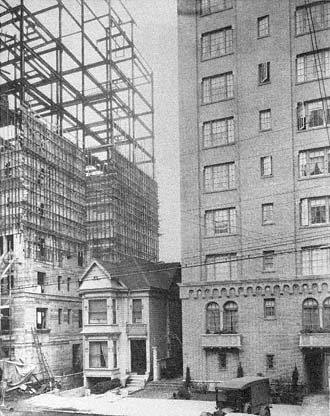
Figure 8.11
Nonuniform development in the northern reaches of
San Francisco's Western Addition, 1927. Investors saw a
surviving Victorian-era house like this, probably a rooming
house, as a threat to the property value of the tall buildings.
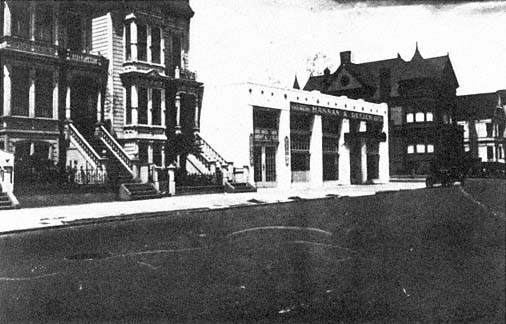
Figure 8.12
The "intrusion" of an auto dealership into a residence district. Illustration of negative land-use
mixture from a 1920 article promoting zoning.
Hotels were allowed in three of the other zoning categories. Mapped as "second residential areas" were the city additions built from 1880 to 1921. In such areas, the zoning ordinance allowed apartments, hotels, and six specified neighborhood institutions (libraries, for instance); however, new stores would not be allowed. Existing streetcar corridors with their lines of shops were in the commercial category, and hotels were allowed there. After a series of political appeals, hotels were also allowed in heavy industrial districts.[38]
With so many areas of San Francisco open to hotels in 1921, the effects of zoning may not seem significant. Indeed, the antihotel ideas within zoning ordinances did not initially affect hotel life significantly; yet they reshaped a debate that had dramatic effects several decades later. On the one hand, zoning gave city officials centralized power over the form of future locations for hotel life. On the other hand, zoning drew a very effective cordon sanitaire around the old city as it had been built by about World War I, to keep old city ideas from contaminating the new city. In these respects, zoning came to be powerful in several ways.
First, the inflexible administration of zoning cut off suburban hotel experiments such as the hotels built over corner groceries or corner bars in new additions to the city. Zoning laws and opinions could have been written to keep only the worst aspects of mixed use and mixed building types out of urban expansion. Bulk, occupancy, or lot-coverage guidelines written as performance criteria rather than as absolute proscriptions might have allowed hotel managers to continue experimenting with expensive one- or two-story hotels whose form, image, and clientele would have blended even with new automobile suburbs. Ample precedents for such congenial mixtures could be found in country clubs that coexisted with the most exclusive suburbs.[39] Had suburban developers actively fought for such variety in early applications of zoning, they probably would have won over the experts' objections.
Second, zoning retarded the establishment of new rooming houses even in those extensive older areas of San Francisco designated as second residential districts. New hotels were entirely legal in these areas, but zoning forbade other new commercial uses. Hence, the critically important tenant services and cash flow from first-floor business were
unhinged from the rooming house business above, sharply reducing profits.[40]
Third, the long strips of commercially zoned blocks on either side of streetcar and new automobile through-routes proved to be inhospitable to new hotel life. The older streetcar strips and nodes already had a mixture of hotels and rooming houses. At the newer edges of the city, hotel residents found incomplete commercial services, a narrow range of prices, or too little variety: eating at the same inexpensive restaurant every day did not support convivial hotel life. Farther out, in nascent automobile strips, pedestrian life was unpleasant.
A fourth effect was a consequence of eliminating rooming houses in suburbs. Rooming houses had allowed women to make a living within one of their traditional roles, keeping house.[41] Zoning in effect eliminated expansion of these women's businesses.
Fifth, a succession of court decisions supported the elite and professional opinion that hotels should be excluded not only from the growing edges of the city but also from the entire city. It did not matter that hotels were popular or necessary or chosen as homes by a fraction of the downtown public.
The early court cases testing zoning show the degree to which hotels and rooming houses were on the minds of urban land-use experts. Initial state supreme court reviews disagreed about such basics as any land-use exclusions and zoning's uses of the police power; thus, excluding hotels, flats, and apartments from areas of single-family houses was logically more difficult for the courts. Miller v. Los Angeles , an influential case heard in 1925 before the California Supreme Court, summarized several earlier antihotel court opinions. The judges upheld the exclusion of a four-flat building from an area of single-family houses, and their opinion ranged widely to discuss apartments and hotels as well as flats.[42] They admitted that "undoubtedly, many families do maintain ideal home life in apartments, flats, and hotels" and that "in many single family dwellings there is much of dissention and discord." Nonetheless, the court also assumed that life in apartments and hotels was never chosen:
Few persons, if given their choice, would, we think, deliberately prefer to establish their homes and rear their children in an apartment house neighborhood
rather than in a single home neighborhood. . . . It is needless to further analyze and enumerate all of the factors which make a single family home more desirable for the promotion and perpetuation of family life than an apartment, hotel, or flat.[43]
This ruling influenced other courts. The Minnesota Supreme Court in 1925 rationalized exclusion of multiple-family structures as a reasonable reaction to urban population pressures.[44] A judge in Cleveland, Ohio, bluntly repeated the opinion that apartment buildings not only spread infectious diseases but also promoted immorality.[45] Many of the court opinions invoked expert academic scholarship—like that of the Chicago school of sociology—to reject apartments and hotels as valid housing. A law review article said "sound sociological arguments" led to the belief that open-lot houses were better than flats.[46] In fairly subtle ways, the decades of objections to hotel life by national figures such as Veiller, Woods, Abbott, and Park and California figures like Lubin and Porter had an important effect.
The gathering of antihotel opinion was particularly clear in 1926, when the Supreme Court of the United States handed down its decision on Euclid v. Ambler , the landmark zoning case concerning a Cleveland, Ohio, suburb and a small local realty company.[47] Writing for the court, the archconservative justice, George Sutherland, not only upheld the private house ideal but also helped to relegate all hotels and apartments into the category of hazards for the new city. Sutherland found no problem supporting the exclusion of industrial activity (as a nuisance) from residential areas; more difficult, he said, would be the "creation and maintenance of residential districts, from which business and trade of every sort, including hotels and apartment houses, are excluded." For this exclusion, the court could not rely solely on the concept of nuisance. Instead, said Sutherland, the court was convinced by "much attention at the hands of commissions and experts" that apartments and hotels, like steel mills, were a hazard to public health and safety when they were placed next to single-family houses (fig. 8.13). Within one year after Euclid v. Ambler , forty-five states had enacted enabling legislation for local zoning. Municipal and state courts were henceforth freed from the narrow confines of the common law of nuisance and police power that had constrained the limits of earlier building and health codes.
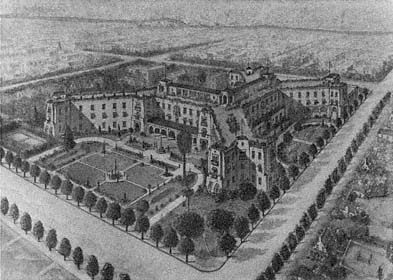
Figure 8.13
An apartment and tourist hotel in a residence district of the San Francisco
Bay Area suburb of Alameda. Opinions on the mixture of houses
and hotels varied widely: the city's Chamber of Commerce began this
hotel in 1926, the same year as the Euclid v. Ambler ruling. In the 1990s,
small bungalows and Victorian houses still abutted the hotel on two sides.
In 1932, President Herbert Hoover summed up the argument: "Zoning and city planning save waste, reduce ultimate costs, and add attractiveness and other social values to stable investment values for home owners."[48] For Hoover, investment stability was the ultimate social aim, just as it was for the majority of those who gained from the notion of an immutable new city. When reformers elevated the ideal of the privately owned American home as the single goal of national policy, the idea grew dramatically in power. This single-minded focus on the single-house concept would become in itself another strategy for eliminating hotels and apartments.